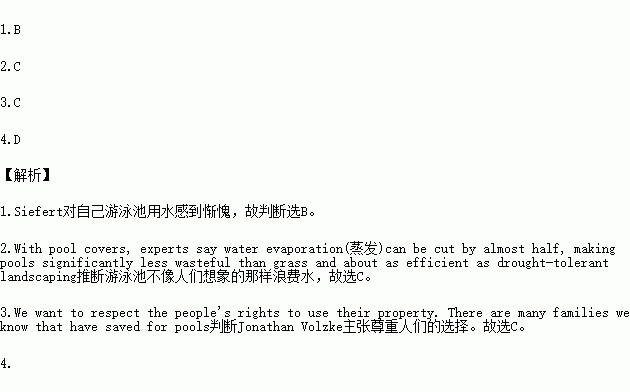题目内容
B
The Sieferts are the kind of environmentally conscious family who has solar panels atop their home. They use timers on their kids' showers and have planted drought-tolerant landscaping. But they feel kind of guilt. “I haven’t thought about the pool as much as I probably should,” said Annette Siefert.
As California's drought worsens, swimming pools have become a target for those who think the classic backyard greens waste water. Some water districts have banned new pools from being filled and have limited how much water existing pools can use.
But some of those agencies are walking back the rules as they make a surprising discovery: Pools aren't the water wasters some have made them out to be. Analyses by various water districts, along with scientific studies, conclude that pools and their surrounding landscapes use about the same amount of water as a lawn(草坪) of the same size. Over time, pools might even use less water. With pool covers, experts say water evaporation(蒸发)can be cut by almost half, making pools significantly less wasteful than grass and about as efficient as drought-tolerant landscaping.
Facing complaints over a recent ban on filling pools, the Santa Margarita Water District conducted its own water-use analysis. It found that pools require thousands of gallons of water to fill initially, but they use about 8,000 gallons less water than a traditional landscape after that. By the third year, the analysis found, the savings add up, and a pool's cumulative water use falls below that of a lawn.
Water agencies such as the Los Angeles Department of Water and Power have come to similar conclusions. Armed with new information, Santa Margarita Water District officials will reconsider their ban next week.
“We want to respect the people's rights to use their property. There are many families we know that have saved for pools,” said Jonathan Volzke, spokesman for the 155,000-customer district. “But at the same time, the reality around us is that we're in the third year of a serious drought, and we don't know if we're in the third year of a three-year drought or the third year of a 10-year drought.”
1.Annette Siefert feels guilty mainly because of ______.
A. being a typical water waster
B. the water-use of their swimming pool
C. her control over her kids' showers at home
D. the construction of the drought-tolerant landscaping
2.According to analyses and scientific studies, a swimming pool ______.
A. had belter be filled up in the beginning
B. becomes more efficient against drought
C. isn't what people think to be wasteful of water
D. consumes more water than a lawn of the same size
3.What does Jonathan Volzke try to express in the last paragraph?
A. He expects the serious drought to come to an end.
B. He thinks highly of those who have saved for pools.
C. He appeals for reasonable use of the swimming pools.
D. He tries to maintain the right to use the swimming pools.
4.What would be the best title for the passage?
A. Water Crisis In California
B. Strict Ban On Filling Pools
C. The Sieferts—Real Environmentalists?
D. Pools—A Big Factor During Drought?

